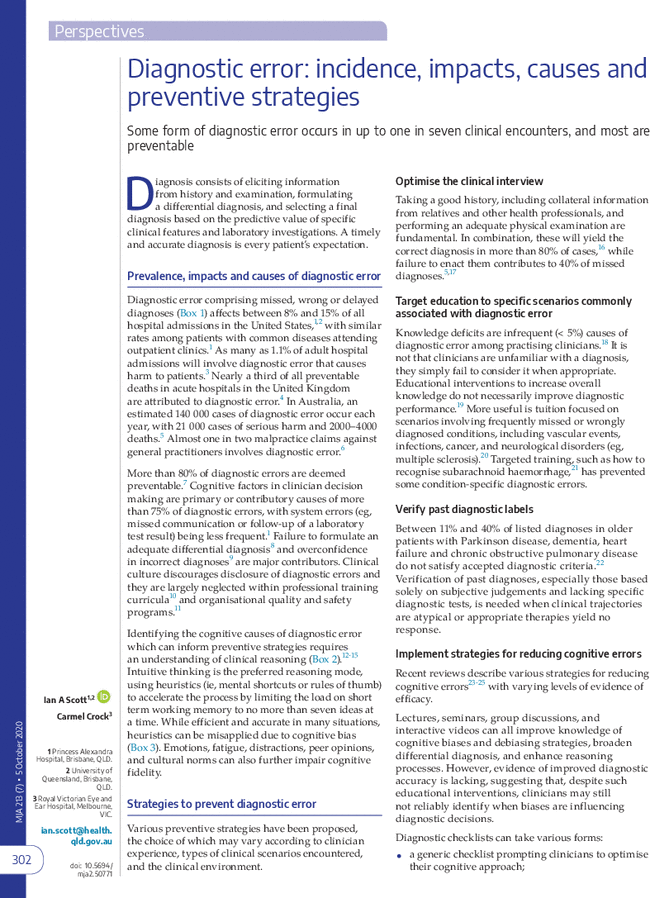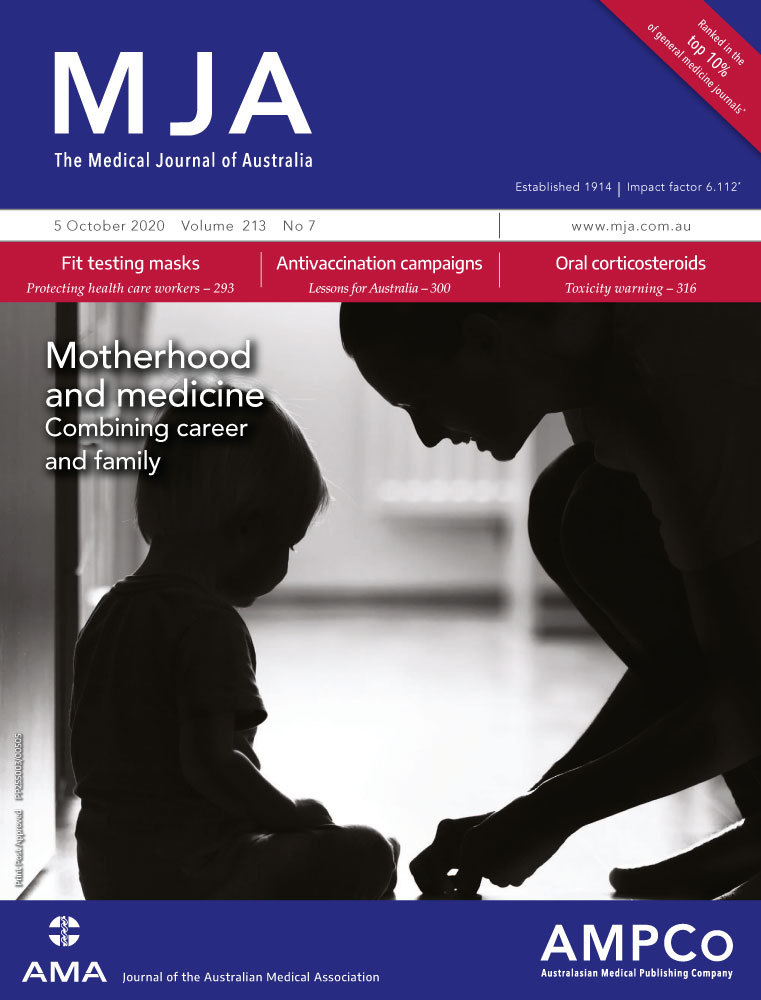Perspectives
Diagnostic error: incidence, impacts, causes and preventive strategies
Ian A Scott,
Carmel Crock,
Corresponding Author
Ian A Scott
Princess Alexandra Hospital, Brisbane, QLD
University of Queensland, Brisbane, QLD
Correspondence
Search for more papers by this authorCarmel Crock
Royal Victorian Eye and Ear Hospital, Melbourne, VIC
Search for more papers by this authorIan A Scott,
Carmel Crock,
Corresponding Author
Ian A Scott
Princess Alexandra Hospital, Brisbane, QLD
University of Queensland, Brisbane, QLD
Correspondence
Search for more papers by this authorCarmel Crock
Royal Victorian Eye and Ear Hospital, Melbourne, VIC
Search for more papers by this author
Supporting Information
| Filename | Description |
|---|---|
| mja250771-sup-0001-Supinfo.pdfPDF document, 224.4 KB | Supplementary table |
Please note: The publisher is not responsible for the content or functionality of any supporting information supplied by the authors. Any queries (other than missing content) should be directed to the corresponding author for the article.
References
- 1Graber ML. The incidence of diagnostic error in medicine. BMJ Qual Saf 2013; 22 (Suppl): ii21-ii27.
- 1Winters B, Custer J, Galvagno SM, et al. Diagnostic errors in the intensive care unit: a systematic review of autopsy studies. BMJ Qual Saf 2012; 21: 894–902.
- 1Gunderson CG, Bilan VP, Holleck JL, et al. Prevalence of harmful diagnostic errors in hospitalised adults: a systematic review and meta-analysis. BMJ Qual Saf 2020; https://doi.org/10.1136/bmjqs-2019-010822 [Epub ahead of print].
- 1Hogan H, Healey F, Neale G, et al. Preventable deaths due to problems in care in English acute hospitals: a retrospective case record review study. BMJ Qual Saf 2012; 21: 737–745.
- 1 Sax Institute. Knowledge lacking on scale of diagnostic error problem. Sax Institute, 2013. https://www.saxinstitute.org.au/news/knowledge-lacking-on-scale-of-diagnostic-error-problem/ (viewed Aug 2020).
- 1Bird S. Diagnostic tests and litigation. Aust Prescr 2012; 35: 106–107.
- 1Zwaan L, de Bruijne M, Wagner C, et al. Patient record review of the incidence, consequences, and causes of diagnostic adverse events. Arch Intern Med 2010; 170: 1015–1021.
- 1Singh H, Giardina TD, Meyer AN, et al. Types and origins of diagnostic errors in primary care settings. JAMA Intern Med 2013; 25(173): 418–425.
10.1001/jamainternmed.2013.2777 Google Scholar
- 1Meyer AN, Payne VL, Meeks DL, et al. Physicians’ diagnostic accuracy, confidence, and resource requests: a vignette study. JAMA Intern Med 2013; 173: 1952–1958.
- 1Simpkin AL, Vyas JM, Armstrong KA. Diagnostic reasoning: An endangered competency in internal medicine training. Ann Intern Med 2017; 167: 507–509.
- 1Graber M. Diagnostic errors in medicine: a case of neglect. Jt Comm J Qual Patient Saf 2005; 31: 106–113.
- 1Schmidt HG, Mamede S. How to improve the teaching of clinical reasoning: a narrative review and a proposal. Med Educ 2015; 49: 961–973.
- 1Ericsson KA. Deliberate practice and the acquisition and maintenance of expert performance in medicine and related domains. Acad Med 2004; 79: S70–S81.
- 1Kahneman D. Thinking, fast and slow. LondonPenguin, 2012.
- 1Norman GR, Monteiro SD, Sherbino J, et al. The causes of errors in clinical reasoning: cognitive biases, knowledge deficits, and dual process thinking. Acad Med 2017; 92: 23–30.
- 1Paley L, Zornitzki T, Cohen J, et al. Utility of clinical examination in the diagnosis of emergency department patients admitted to the department of medicine of an academic hospital. Arch Intern Med 2011; 171: 1393–1400.
- 1Verghese A, Charlton B, Kassirer JP, et al. Inadequacies of physical examination as a cause of medical errors and adverse events: a collection of vignettes. Am J Med 2015; 128: 1322–1324.
- 1Schiff GD, Puopolo AL, Huben-Kearney A, et al. Primary care closed claims experience of Massachusetts malpractice insurers. JAMA Intern Med 2013; 173: 2063–2068.
- 1Bowen JL. Educational strategies to promote clinical diagnostic reasoning. N Engl J Med 2006; 355: 2217–2225.
- 1Newman-Toker DE, Schaffer AC, Yu-Moe CW, et al. Serious misdiagnosis-related harms in malpractice claims: the “Big Three” — vascular events, infections, and cancers. Diagnosis 2019; 6: 227–240.
- 1Fridriksson S, Hillman J, Landtblom AM, Boive J. Education of referring doctors about sudden onset headache in subarachnoid hemorrhage. A prospective study. Acta Neurol Scand 2001; 103: 238–242.
- 1Skinner T, Scott IA, Martin JH. Diagnostic errors in older patients: a systematic review of incidence and potential causes in seven prevalent diseases. Int J Gen Med 2016; 9: 137–146.
- 1Croskerry P, Singhal G, Mamede S. Cognitive debiasing 2: impediments to and strategies for change. BMJ Qual Saf 2013; 22(Suppl): ii65-ii72.
- 1Graber ML, Kissam S, Payne VL, et al. Cognitive interventions to reduce diagnostic error: a narrative review. BMJ Qual Saf 2012; 21: 535–557.
- 1Lambe KA, O’Reilly G, Kelly BD, et al. Dual-process cognitive interventions to enhance diagnostic reasoning: a systematic review. BMJ Qual Saf 2016; 25: 808–820.
- 1Ely JW, Graber ML, Croskerry P. Checklists to reduce diagnostic errors. Acad Med 2011; 86: 307–312.
- 1Schiff GD, Leape L. How can we make diagnosis safer? Acad Med 2012; 87: 135–138.
- 1Sibbald M, de Bruin ABH, van Merrienboer JJG. Checklists improve experts’ diagnostic decisions. Med Educ 2013; 47: 301–308.
- 1Shimizu T, Matsumoto K, Tokuda Y. Effects of the use of differential diagnosis checklist and general de-biasing checklist on diagnostic performance in comparison to intuitive diagnosis. Med Teach 2013; 35: e1218–e1229.
- 1Croskerry P. Cognitive forcing strategies in clinical decision-making. Ann Emerg Med 2003; 41: 110–120.
- 1Feyzi-Behnagh R, Azevedo R, Legowski E, et al. Metacognitive scaffolds improve self-judgments of accuracy in a medical intelligent tutoring system. Inst Sci 2014; 42: 159–181.
- 1Sherbino J, Kulasegaram K, Howey E, et al. Ineffectiveness of cognitive forcing strategies to reduce biases in diagnostic reasoning: a controlled trial. CJEM 2014; 16: 34–40.
- 1Arzy S, Brezis M, Khoury S, et al. Misleading one detail: a preventable mode of diagnostic error? J Eval Clin Pract 2009; 15: 804–806.
- 1Myung SJ, Kang SH, Phyo SR, et al. Effect of enhanced analytic reasoning on diagnostic accuracy: a randomized controlled study. Med Teach 2013; 35: 248–250.
- 1Ilgen JS, Bowen JL, Yarris LM, et al. Adjusting our lens: can developmental differences in diagnostic reasoning be harnessed to improve health professional and trainee assessment? Acad Emerg Med 2011; 18 (Suppl): S79–S86.
- 1Mamede S, Schmidt HG, Rikers RMJP, et al. Conscious thought beats deliberation without attention in diagnostic decision-making: at least when you are an expert. Psychol Res 2010; 74: 586–592.
- 1Pinnock R, Young L, Spence F, et al. Can think aloud be used to teach and assess clinical reasoning in graduate medical education? J Grad Med Educ 2015; 7: 334–337.
- 1Ibiapina C, Mamede S, Moura A, et al. Effects of free, cued and modelled reflection on medical students’ diagnostic competence. Med Educ 2014; 48: 796–805.
- 1Sibbald M, de Bruin ABH. Feasibility of self-reflection as a tool to balance clinical reasoning strategies. Adv Health Sci Educ Theory Pract 2012; 17: 419–429.
- 1Barnett ML, Boddupalli D, Nundy S, Bates DW. Comparative accuracy of diagnosis by collective intelligence of multiple physicians vs individual physicians. JAMA Netw Open 2019; 2: e190096.
- 1 Commonwealth of Massachusetts Board of Registration in Medicine; Quality and Patient Safety Division. Advisory: diagnostic process in inpatient and emergency department settings (Mar 2016). www.mass.gov/eohhs/docs/borim/cde-advisory.pdf (viewed June 2019).
- 1Meyer A, Singh H. The path to diagnostic excellence includes feedback to calibrate how clinicians think. JAMA 2019; 321: 737–738.
- 1Schiff GD. Minimising diagnostic error: the importance of follow-up and feedback. Am J Med 2008; 121 (Suppl): S38–S42.
- 1Ismail AA. When laboratory tests can mislead even when they appear plausible. Clin Med 2017; 17: 329–332.
- 1Moulton CE, Regehr G, Mylopoulous M, et al. Slowing down when you should: a new model of expert judgment. Acad Med 2007; 82: S109–S116.
- 1Reilly JB, Myers JS, Salvador D, Trowbridge RL. Use of a novel, modified fishbone diagram to analyze diagnostic errors. Diagnosis (Berl) 2014; 1: 167–171.
- 1Riches N, Panagioti M, Alam R, et al. The effectiveness of electronic differential diagnoses (DDX) generators: a systematic review and meta-analysis. PLoS One 2016; 11: e0148991.
- 1Chou W, Tien P, Lin F, et al. Application of visually based computerised decision support system in dermatological education: a pilot study. Postgrad Med J 2017; 93: 256–259.
- 1Segal MM, Williams MS, Gropman AL, et al. Evidence-based decision support for neurological diagnosis reduces errors and unnecessary workup. J Child Neurol 2014; 29: 487–492.
- 1McComb S, Bond RR. CoDiagnose: interactive software to harness collaborative diagnoses and to increase diagnostic accuracy among junior physicians. Technol Health Care 2015; 23: 243–256.
- 1Rosser WW, Slawson DC, Shaughnessy AF. Information mastery: evidence-based family medicine (2nd ed). Hamilton, OntarioBC Decker, 2004.
- 1Bhise V, Meyer AN, Menon S, et al. Patient perspectives on how physicians communicate diagnostic uncertainty: an experimental vignette study. Int J Qual Health Care 2018; 30: 2–8.
- 1Schiff GD, Kroenke K, Lambert B, et al. Ten principles for more conservative, care-full diagnosis. Ann Intern Med 2019; 170: 823–824.
- 1Peabody JW, Luck J, Glassman P, et al. Comparison of vignettes, standardized patients, and chart abstraction: a prospective validation study of 3 methods for measuring quality. JAMA 2000; 283: 1715–1722.




